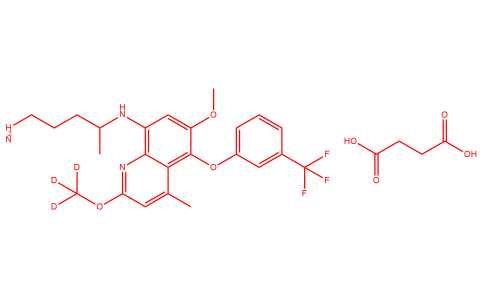Tafenoquine-d3 succinate
Tafenoquine-d3 is a trideuerium-labeled Tafenoquine derivative. Tafenoquine, also known as WR-238605, is an oral active antimalaria drug that is being investigated as a potential treatment for malaria, as well as for malaria prevention. Tafenoquine Shows Activity against Trypanosoma brucei. Tafenoquine targets leishmania respiratory complex III and induces apoptosis. Tafenoquine has a long half-life of approximately 14 days and is generally safe and well tolerated, Malaria remains an important cause of global morbidity and mortality. As antimalarial drug resistance escalates, new safe and effective medications are necessary to prevent and treat malarial infection.
For research use only. We do not sell to patients.
Chemical Information
| Name | Tafenoquine-d3 succinate |
|---|---|
| Iupac Chemical Name | N4-(6-methoxy-2-(methoxy-d3)-4-methyl-5-(3-(trifluoromethyl)phenoxy)quinolin-8-yl)pentane-1,4-diamine succinoic acid |
| Synonyms | WR-238605, WR 238605, WR238605, Tafenoquine; trideuerium-labeled Tafenoquine derivative; Tafenoquine-d3 succinate |
| Molecular Formula | C28H31D3F3N3O7 |
| Molecular Weight | 584.61 |
| Smile | CC(NC1=C2N=C(OC([2H])([2H])[2H])C=C(C)C2=C(OC3=CC=CC(C(F)(F)F)=C3)C(OC)=C1)CCCN.O=C(O)CCC(O)=O |
| InChiKey | CQBKFGJRAOXYIP-NXIGQQGZSA-N |
| InChi | InChI=1S/C24H28F3N3O3.C4H6O4/c1-14-11-20(32-4)30-22-18(29-15(2)7-6-10-28)13-19(31-3)23(21(14)22)33-17-9-5-8-16(12-17)24(25,26)27;5-3(6)1-2-4(7)8/h5,8-9,11-13,15,29H,6-7,10,28H2,1-4H3;1-2H2,(H,5,6)(H,7,8)/i4D3; |
| CAS Number | 1133378-83-2 |
| Related CAS |
Ordering Information
| Packaging | Price | Availability | Purity | Shipping Time |
|---|---|---|---|---|
| Bulk | Enquiry | Enquiry | Enquiry |
| Formulation | Solid powder |
|---|---|
| Purity | 98% Min. |
| Storage | Dry, dark and at 0 - 4 C for short term (days to weeks) or -20 C for long term (months to years). |
| Solubility | Soluble in DMSO |
| Handling | |
| Shipping Condition | Shipped under ambient temperature as non-hazardous chemical. This product is stable enough for a few weeks during ordinary shipping and time spent in Customs. |
| HS Code |
| Targets | |
|---|---|
| Mechanism | |
| Cell study | |
| Animal study | |
| Clinical study |
1: Haston JC, Hwang J, Tan KR. Guidance for Using Tafenoquine for Prevention and Antirelapse Therapy for Malaria - United States, 2019. MMWR Morb Mortal Wkly Rep. 2019 Nov 22;68(46):1062-1068. doi: 10.15585/mmwr.mm6846a4. Review. PubMed PMID: 31751320.
2: LiverTox: Clinical and Research Information on Drug-Induced Liver Injury [Internet]. Bethesda (MD): National Institute of Diabetes and Digestive and Kidney Diseases; 2012-. Available from http://www.ncbi.nlm.nih.gov/books/NBK548428/ PubMed PMID: 31643747.
3: Tafenoquine succinate for malaria prevention. Aust Prescr. 2019 Jun;42(3):110-111. doi: 10.18773/austprescr.2019.034. Epub 2019 Apr 24. Review. PubMed PMID: 31363314; PubMed Central PMCID: PMC6594846.
4: Hounkpatin AB, Kreidenweiss A, Held J. Clinical utility of tafenoquine in the prevention of relapse of Plasmodium vivax malaria: a review on the mode of action and emerging trial data. Infect Drug Resist. 2019 Mar 6;12:553-570. doi: 10.2147/IDR.S151031. eCollection 2019. Review. PubMed PMID: 30881061; PubMed Central PMCID: PMC6411314.
5: Berman J, Brown T, Dow G, Toovey S. Tafenoquine and primaquine do not exhibit clinical neurologic signs associated with central nervous system lesions in the same manner as earlier 8-aminoquinolines. Malar J. 2018 Nov 6;17(1):407. doi: 10.1186/s12936-018-2555-3. Review. PubMed PMID: 30400893; PubMed Central PMCID: PMC6219089.
6: Frampton JE. Tafenoquine: First Global Approval. Drugs. 2018 Sep;78(14):1517-1523. doi: 10.1007/s40265-018-0979-2. Review. PubMed PMID: 30229442.
7: Drugs and Lactation Database (LactMed) [Internet]. Bethesda (MD): National Library of Medicine (US); 2006-. Available from http://www.ncbi.nlm.nih.gov/books/NBK525504/ PubMed PMID: 30222296.
8: Dow G, Smith B. The blood schizonticidal activity of tafenoquine makes an essential contribution to its prophylactic efficacy in nonimmune subjects at the intended dose (200 mg). Malar J. 2017 May 19;16(1):209. doi: 10.1186/s12936-017-1862-4. Review. PubMed PMID: 28526056; PubMed Central PMCID: PMC5438551.
9: Ebstie YA, Abay SM, Tadesse WT, Ejigu DA. Tafenoquine and its potential in the treatment and relapse prevention of Plasmodium vivax malaria: the evidence to date. Drug Des Devel Ther. 2016 Jul 26;10:2387-99. doi: 10.2147/DDDT.S61443. eCollection 2016. Review. PubMed PMID: 27528800; PubMed Central PMCID: PMC4970641.
10: Rajapakse S, Rodrigo C, Fernando SD. Tafenoquine for preventing relapse in people with Plasmodium vivax malaria. Cochrane Database Syst Rev. 2015 Apr 29;(4):CD010458. doi: 10.1002/14651858.CD010458.pub2. Review. PubMed PMID: 25921416; PubMed Central PMCID: PMC4468925.
11: Crockett M, Kain KC. Tafenoquine: a promising new antimalarial agent. Expert Opin Investig Drugs. 2007 May;16(5):705-15. Review. PubMed PMID: 17461742.
12: Peters W. The evolution of tafenoquine--antimalarial for a new millennium? J R Soc Med. 1999 Jul;92(7):345-52. Review. PubMed PMID: 10615272; PubMed Central PMCID: PMC1297286.
Chemical Structure

